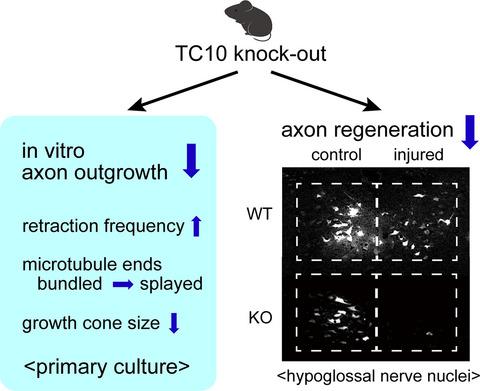当前位置:
X-MOL 学术
›
J. Neurochem.
›
论文详情
Our official English website, www.x-mol.net, welcomes your
feedback! (Note: you will need to create a separate account there.)
TC10, a Rho family GTPase, is required for efficient axon regeneration in a neuron-autonomous manner
Journal of Neurochemistry ( IF 4.2 ) Pub Date : 2020-11-06 , DOI: 10.1111/jnc.15235 Shingo Koinuma 1 , Ryota Negishi 1, 2 , Riko Nomura 1, 3 , Kazuki Sato 1 , Takuya Kojima 4 , Eri Segi-Nishida 3 , Ryo Goitsuka 1 , Yoichiro Iwakura 1 , Naoyuki Wada 2 , Yoshiki Koriyama 5 , Sumiko Kiryu-Seo 6 , Hiroshi Kiyama 6 , Takeshi Nakamura 1
Journal of Neurochemistry ( IF 4.2 ) Pub Date : 2020-11-06 , DOI: 10.1111/jnc.15235 Shingo Koinuma 1 , Ryota Negishi 1, 2 , Riko Nomura 1, 3 , Kazuki Sato 1 , Takuya Kojima 4 , Eri Segi-Nishida 3 , Ryo Goitsuka 1 , Yoichiro Iwakura 1 , Naoyuki Wada 2 , Yoshiki Koriyama 5 , Sumiko Kiryu-Seo 6 , Hiroshi Kiyama 6 , Takeshi Nakamura 1
Affiliation

|
Intracellular signaling pathways that promote axon regeneration are closely linked to the mechanism of neurite outgrowth. TC10, a signaling molecule that acts on neurite outgrowth through membrane transport, is a member of the Rho family G proteins. Axon injury increases the TC10 levels in motor neurons, suggesting that TC10 may be involved in axon regeneration. In this study, we tried to understand the roles of TC10 in the nervous system using TC10 knock-out mice. In cultured hippocampal neurons, TC10 ablation significantly reduced axon elongation without affecting ordinary polarization. We determined a role of TC10 in microtubule stabilization at the growth cone neck; therefore, we assume that TC10 limits axon retraction and promotes in vitro axon outgrowth. In addition, there were no notable differences in the size and structure of brains during prenatal and postnatal development between wild-type and TC10 knock-out mice. In motor neurons, axon regeneration after injury was strongly suppressed in mice lacking TC10 (both in conventional and injured nerve specific deletion). In retinal ganglion cells, TC10 ablation suppressed the axon regeneration stimulated by intraocular inflammation and cAMP after optic nerve crush. These results show that TC10 plays an important role in axon regeneration in both the peripheral and central nervous systems, and the role of TC10 in peripheral axon regeneration is neuron-intrinsic.
中文翻译:

TC10,Rho家族GTPase,是神经元自主方式有效轴突再生所必需的
促进轴突再生的细胞内信号通路与神经突生长机制密切相关。TC10是通过膜转运作用于神经突生长的信号分子,是Rho家族G蛋白的成员。轴突损伤增加了运动神经元中TC10的水平,表明TC10可能参与了轴突的再生。在这项研究中,我们试图使用TC10敲除小鼠了解TC10在神经系统中的作用。在培养的海马神经元中,TC10消融可显着减少轴突伸长,而不会影响普通极化。我们确定了TC10在生长锥颈微管稳定中的作用。因此,我们假设TC10限制了轴突的回缩并促进了体外轴突的生长。此外,野生型和TC10基因敲除小鼠在产前和产后发育过程中大脑的大小和结构没有显着差异。在运动神经元中,缺乏TC10的小鼠(既有常规的也有受伤的神经特异性缺失)均强烈抑制了损伤后的轴突再生。在视网膜神经节细胞中,TC10消融抑制了视神经挤压后眼内炎症和cAMP刺激的轴突再生。这些结果表明,TC10在周围和中枢神经系统的轴突再生中起重要作用,而TC10在周围轴突再生中的作用是神经元固有的。在缺乏TC10的小鼠中,损伤后的轴突再生受到了强烈的抑制(传统的和受损的神经特异性缺失均如此)。在视网膜神经节细胞中,TC10消融抑制了视神经挤压后眼内炎症和cAMP刺激的轴突再生。这些结果表明,TC10在周围和中枢神经系统的轴突再生中起重要作用,而TC10在周围轴突再生中的作用是神经元固有的。在缺乏TC10的小鼠中,损伤后的轴突再生受到了强烈的抑制(传统的和受损的神经特异性缺失均如此)。在视网膜神经节细胞中,TC10消融抑制了视神经挤压后眼内炎症和cAMP刺激的轴突再生。这些结果表明,TC10在周围和中枢神经系统的轴突再生中起重要作用,而TC10在周围轴突再生中的作用是神经元固有的。
更新日期:2020-11-06
中文翻译:

TC10,Rho家族GTPase,是神经元自主方式有效轴突再生所必需的
促进轴突再生的细胞内信号通路与神经突生长机制密切相关。TC10是通过膜转运作用于神经突生长的信号分子,是Rho家族G蛋白的成员。轴突损伤增加了运动神经元中TC10的水平,表明TC10可能参与了轴突的再生。在这项研究中,我们试图使用TC10敲除小鼠了解TC10在神经系统中的作用。在培养的海马神经元中,TC10消融可显着减少轴突伸长,而不会影响普通极化。我们确定了TC10在生长锥颈微管稳定中的作用。因此,我们假设TC10限制了轴突的回缩并促进了体外轴突的生长。此外,野生型和TC10基因敲除小鼠在产前和产后发育过程中大脑的大小和结构没有显着差异。在运动神经元中,缺乏TC10的小鼠(既有常规的也有受伤的神经特异性缺失)均强烈抑制了损伤后的轴突再生。在视网膜神经节细胞中,TC10消融抑制了视神经挤压后眼内炎症和cAMP刺激的轴突再生。这些结果表明,TC10在周围和中枢神经系统的轴突再生中起重要作用,而TC10在周围轴突再生中的作用是神经元固有的。在缺乏TC10的小鼠中,损伤后的轴突再生受到了强烈的抑制(传统的和受损的神经特异性缺失均如此)。在视网膜神经节细胞中,TC10消融抑制了视神经挤压后眼内炎症和cAMP刺激的轴突再生。这些结果表明,TC10在周围和中枢神经系统的轴突再生中起重要作用,而TC10在周围轴突再生中的作用是神经元固有的。在缺乏TC10的小鼠中,损伤后的轴突再生受到了强烈的抑制(传统的和受损的神经特异性缺失均如此)。在视网膜神经节细胞中,TC10消融抑制了视神经挤压后眼内炎症和cAMP刺激的轴突再生。这些结果表明,TC10在周围和中枢神经系统的轴突再生中起重要作用,而TC10在周围轴突再生中的作用是神经元固有的。











































 京公网安备 11010802027423号
京公网安备 11010802027423号